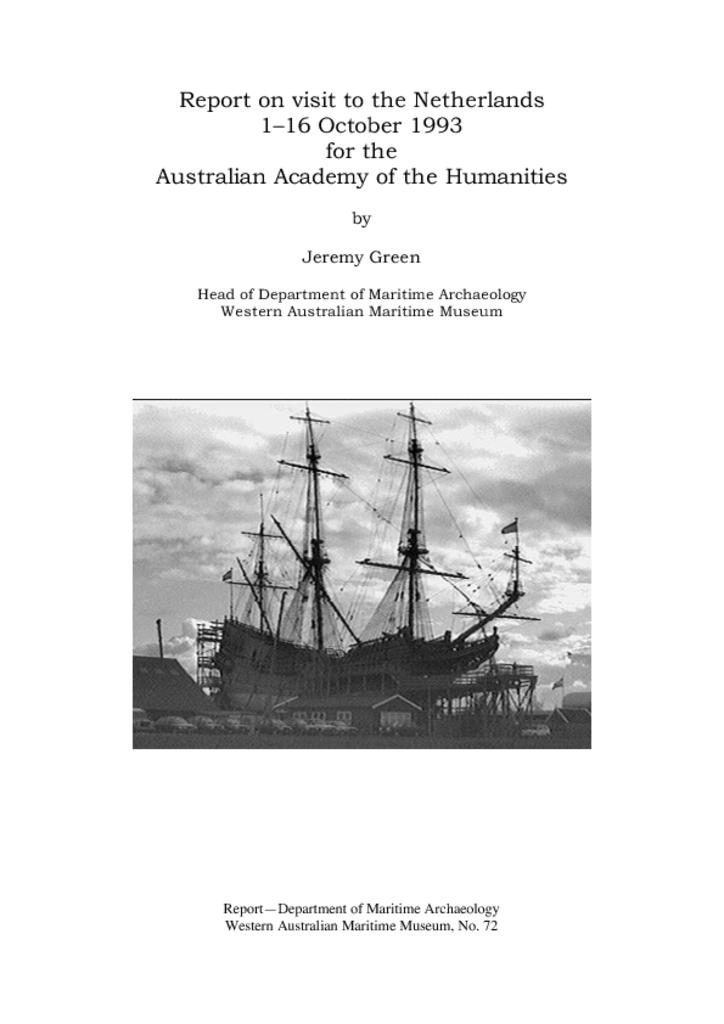Report on visit to the Netherlands 1–16 October 1993 for the Australian Academy of the Humanities
Author/s J.N. Green
Year of publication 1993
Report Number: 72
Introduction
The Maritime Archaeological, Historical and Ethnographic Investigation of Maritime Technology in the Pre-Modern Period, with Particular Reference to the Batavia and shell-first construction.
Over the past fifteen years I have been involved with a number of other colleagues, in maritime archaeological projects related to the study of Dutch shipwrecks on the Western Australian coast. This work has involved the study of shipbuilding, maritime archaeology and maritime technology and has, over the years, been partially funded by ARC grants. This has resulted an impressive research programme and numerous developments involving the field of maritime archaeology and maritime history.
Initially I held an ARGC Project Grant related to the work of the Western Australian Maritime Museum on the Dutch shipwrecks. This work identified a maritime archaeological research project related to this Dutch wreck material. The project firstly studied European ships involved in the Asiatic trade; the VOC ships. However, the recovery and reconstruction of a section of the Batavia enabled the study of the construction of one particular vessel in great detail, together with the artefact assemblage associated with that site. Following a three month visit to the Lelystad Project, in the Netherlands, where a replica of the Batavia was being built according to historical records, a more broad ranging project was formulated involving the study of trade and maritime technology through maritime archaeology and maritime history. As a result, a reciprocal research programme between the Lelystad Project and the Western Australian Maritime Museum has developed. Clearly the study of these two ‘versions’ of the Batavia is of great significance.
This research has not only implications for our understanding of the history of European technology, but it is vital to our understanding of the processes of maritime trade that were central to cultural diffusion and adaptation of the Europeans throughout the maritime littoral of the world, but is also relevant to the development of the VOC in the Netherlands. In particular the Batavia represents one of the only examples of a VOC ship that has been excavated in an archaeological manner and is at present available for display and for academic research.
Australia’s relevance in the international field of maritime archaeological research needs to be appreciated and supported. Of all humanities research within Australia, maritime archaeology has to be one of the most significant new research areas that has one of the best track records as a discipline. This application addresses this area through the study of European ships in the pre-modern time and will involve Australians in an area of special expertise. The results of this work will provide a better understanding of Europe by Australians through publications, lectures, museum displays, university and school courses and through the media in general.
Maritime trade has played an essential part in the development of societies bordering the oceans of the world. Ships carry not just material trade goods, but armies, religions, thought, technology, culture and change. Through the study of this method of transportation we hope to achieve a greater understanding of our past. Australia has a unique position in this field of study and has pioneered much of the development of maritime archaeological expertise on an international level. This application is designed to follow-on the initial programme in increasing Australia’s awareness of its relevance in European maritime heritage. It is now widely accepted that maritime archaeology and its associated sub-disciplines provide a new source of information that enriches our knowledge of the past.
It is hoped that during the period of the grant, investigators will be able to participate in a number of major projects. It is important to emphasize that Dutch wreck programme in Western Australia, has collaborated with a number of major international underwater archaeological projects associated with the VOC. Additionally, it is the result of this programme that Australia, as a whole, has a major maritime archaeological programme that is second to none. Without the support of this grant, it will be impossible to maintain the key Australian presence within the field of study, or benefit from the longterm research significance over the next decades. Through previous involvement, the project team is developing collaborative research projects, which are relevant to this proposal, with the following organizations: the Netherlands Scheepvaart Museum and the Rijksmuseum, Amsterdam and the Batavia Project at Lelystad.
